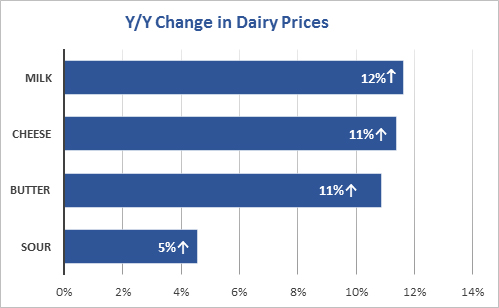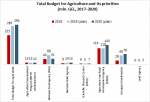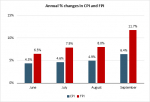In the first half of February, ISET’s Retail Food Price Index increased by 4.8% y/y (compared to February 2017). On a monthly basis (compared to January 2018), food prices in Tbilisi’s major supermarkets held relatively steady and decreased only slightly by 0.1%. The sharpest bi-weekly price changes were recorded for fruits and vegetables. Prices increased the most for eggplant (38%), garlic (19%), and carrots (8.2%). The largest price drops were observed for tangerines (5%), cucumbers (5%), and coriander (2%).
A CLOSER LOOK AT DAIRY MARKET
Dairy prices have shown a strong start for the year. As shown in the diagram, in January 2018, prices are higher for all dairy products compared to the same month of previous year: milk (12%↑), cheese (11%↑), butter (11%↑), and matsoni (5%↑). Given that in winter, there is a shortage in milk supply, increased dairy prices in that period can be explained by seasonality. While seasonality is a good explanation for monthly changes, it cannot explain annual changes in prices.
 Trade data, on the contrary, can provide some interesting insights. According to the export data, export of live bovine animals increased in 2017 compared to the previous year. Thus, the number of live bovine animals exported in 2017 amounted to 132,799 head, which is 34% higher than the same indicator in 2016. The export of fresh meat in 2017 has also increased significantly, by 22%, compared to the previous year. It might be the case that both heifers and cows are exported, therefore, increased exports of live bovine animals, alongside increased exports of meat, might explain a reduction in the supply of milk and resulting higher dairy prices.
Trade data, on the contrary, can provide some interesting insights. According to the export data, export of live bovine animals increased in 2017 compared to the previous year. Thus, the number of live bovine animals exported in 2017 amounted to 132,799 head, which is 34% higher than the same indicator in 2016. The export of fresh meat in 2017 has also increased significantly, by 22%, compared to the previous year. It might be the case that both heifers and cows are exported, therefore, increased exports of live bovine animals, alongside increased exports of meat, might explain a reduction in the supply of milk and resulting higher dairy prices.
It is worth noting that import data shows a significant 42% increase in milk and milk product imports in January 2018, as compared to January 2017. It appears that Georgian retailers try, although not very successfully, to fill the shortage in milk supply with imported dairy products.
Food Price Index Recent Publications
-
JUNE 2021 | AGRI REVIEW
 On 15 June 2021, the National Statistics Office of Georgia published its annual publication for the agricultural sector - Agriculture of Georgia 2020. According to the publication, agriculture, forestry, and fishing comprised 8.4% of GDP in 2020, higher than the 7.2% share in 2019, but in line with the general trend over the last five years (agricultural GDP comprising on average 7-8% of GDP). Agricultural GDP in nominal terms increased by 13% on an annual basis.… Read More
On 15 June 2021, the National Statistics Office of Georgia published its annual publication for the agricultural sector - Agriculture of Georgia 2020. According to the publication, agriculture, forestry, and fishing comprised 8.4% of GDP in 2020, higher than the 7.2% share in 2019, but in line with the general trend over the last five years (agricultural GDP comprising on average 7-8% of GDP). Agricultural GDP in nominal terms increased by 13% on an annual basis.… Read More
-
MARCH 2021 | AGRI REVIEW
 On 29 December 2020, the parliament of Georgia approved the state budget for 2021, which includes allocations of around 18.3 billion GEL. From which the Ministry of Environmental Protection and Agriculture (MEPA) will receive 451.6 million (2.5% of the total budget allocation). MEPA will direct 10 mln. GEL towards the Environmental Protection and Agriculture Development Program (2.2% of MEPA’s total budget), with around 389.6 mln. (86.3% of MEPA’s total budget) to be allocated to agricultural… Read More
On 29 December 2020, the parliament of Georgia approved the state budget for 2021, which includes allocations of around 18.3 billion GEL. From which the Ministry of Environmental Protection and Agriculture (MEPA) will receive 451.6 million (2.5% of the total budget allocation). MEPA will direct 10 mln. GEL towards the Environmental Protection and Agriculture Development Program (2.2% of MEPA’s total budget), with around 389.6 mln. (86.3% of MEPA’s total budget) to be allocated to agricultural… Read More
-
DECEMBER 2020 | AGRI REVIEW
 The COVID-19 pandemic raised concerns about the food security of many countries, in particular import-dependent developing countries like Georgia. Trade restrictions imposed by Georgia’s trade partners tightened the supply of some cereals and vegetables, signalling the risk of an increase in food prices. While there is no formal evidence of food insecurity due to the pandemic, given that Georgia is a net importer of wheat the state subsidized wheat imports, and, according to Georgia’s Wheat… Read More
The COVID-19 pandemic raised concerns about the food security of many countries, in particular import-dependent developing countries like Georgia. Trade restrictions imposed by Georgia’s trade partners tightened the supply of some cereals and vegetables, signalling the risk of an increase in food prices. While there is no formal evidence of food insecurity due to the pandemic, given that Georgia is a net importer of wheat the state subsidized wheat imports, and, according to Georgia’s Wheat… Read More
-
OCTOBER 2020 | AGRI REVIEW
 The National Statistics Office of Georgia (GeoStat) recently published its economic review for Quarter II 2020. The publication highlights that agricultural production increased by 4.7% in the second quarter of the year compared to the same period in 2019. Furthermore, agriculture contributed to 10.2% of the country’s total GDP during the same period. In the second quarter of 2020, Foreign Direct Investments (FDI) in agriculture also increased and were almost six times higher than the… Read More
The National Statistics Office of Georgia (GeoStat) recently published its economic review for Quarter II 2020. The publication highlights that agricultural production increased by 4.7% in the second quarter of the year compared to the same period in 2019. Furthermore, agriculture contributed to 10.2% of the country’s total GDP during the same period. In the second quarter of 2020, Foreign Direct Investments (FDI) in agriculture also increased and were almost six times higher than the… Read More
-
JUNE 2020 | AGRI REVIEW
 On 15 June 2020, the National Statistics Office of Georgia published its annual publication for the agricultural sector - Agriculture of Georgia 2019. The publication shows that agriculture, forestry, and fishing comprised 7.2% of the nominal GDP in 2019, slightly lower than the 7.8% share in 2018, but in line with the general trend over the last five years (on average 7-8% of GDP). In nominal terms, the output of agriculture increased by 4% in 2019… Read More
On 15 June 2020, the National Statistics Office of Georgia published its annual publication for the agricultural sector - Agriculture of Georgia 2019. The publication shows that agriculture, forestry, and fishing comprised 7.2% of the nominal GDP in 2019, slightly lower than the 7.8% share in 2018, but in line with the general trend over the last five years (on average 7-8% of GDP). In nominal terms, the output of agriculture increased by 4% in 2019… Read More
-
DECEMBER 2019 | AGRI REVIEW
 On December 10, the parliament of Georgia approved the state budget for 2020. The budget includes allocations of around 14.4 billion GEL. Out of which, the Ministry of Environmental Protection and Agriculture (MEPA) will receive 353 mln. GEL (2.4% of the total budget allocation). MEPA will direct approximately 293 mln. GEL (2.0% of the total budget allocation) towards agricultural development and 60 mln. GEL (0.4%) will be spent on environmental protection. Compared to 2019, the… Read More
On December 10, the parliament of Georgia approved the state budget for 2020. The budget includes allocations of around 14.4 billion GEL. Out of which, the Ministry of Environmental Protection and Agriculture (MEPA) will receive 353 mln. GEL (2.4% of the total budget allocation). MEPA will direct approximately 293 mln. GEL (2.0% of the total budget allocation) towards agricultural development and 60 mln. GEL (0.4%) will be spent on environmental protection. Compared to 2019, the… Read More
-
OCTOBER 2019 | AGRI REVIEW
 On 30 August 2019, a public hearing to discuss Georgia’s Rural and Agricultural Development Strategy for 2021-2027 was conducted at the Ministry of Environmental Protection and Agriculture (MEPA). The new strategy document represents a roadmap for Georgia’s rural and agricultural development for the next decade. The strategy outlines three major goals to be achieved by 2027: 1. Increasing the competitiveness of agricultural and non-agricultural sectors; 2. Sustainable management of natural resources, preservation of ecosystems, and… Read More
On 30 August 2019, a public hearing to discuss Georgia’s Rural and Agricultural Development Strategy for 2021-2027 was conducted at the Ministry of Environmental Protection and Agriculture (MEPA). The new strategy document represents a roadmap for Georgia’s rural and agricultural development for the next decade. The strategy outlines three major goals to be achieved by 2027: 1. Increasing the competitiveness of agricultural and non-agricultural sectors; 2. Sustainable management of natural resources, preservation of ecosystems, and… Read More
- 1
- 2
- 3
- 4
- 5
- 6
- 7
- 8
- 9
- 10











